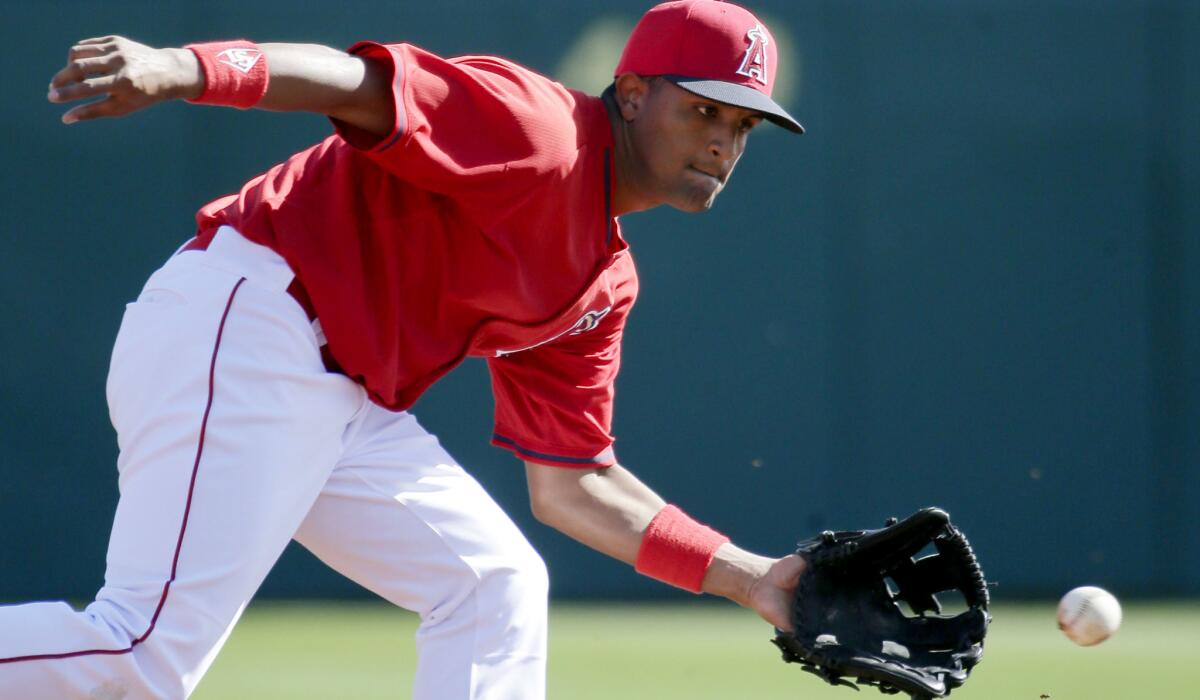Expect Angels to sign several international players when the spending limit is lifted Sunday

- Share via
Carlos Gomez, the Angels’ international scouting director, was standing between fields where minor league games were being played at the team’s Tempe, Ariz., spring-training complex in March as he started to answer a question about Roberto Baldoquin, a Cuban infielder he had pushed to sign late in 2014.
Just then, a hard grounder was hit toward the shortstop and the executive paused mid-thought.
“Please make that play,” Gomez said as he watched Baldoquin scoop up the ball and deliver an on-target throw. “That would suck if he booted it right there.”
Baldoquin’s defense is OK. His hitting is not. At 23, he is struggling in the low minors, an unequivocal flop since the Angels paid nearly $15 million — more than double what had been the international spending record — to sign him.
Because that bonus figure far exceeded their available pool of money, Major League Baseball rules prohibited the Angels from spending more than $300,000 to sign another international prospect for two years. That limit ends Sunday, when the club can again spend up to $4.75 million to sign talented teenagers from foreign lands.
The Angels are expected to sign several, most prominently Bahamian outfielder Trent Deveaux, a top-20 international prospect according to Baseball America. The Bahamas Tribune reported in February that Deveaux and the Angels agreed to a $1.2-million bonus; on his Instagram account, he lists himself as a professional player for the team.
As Gomez fixed his outlook toward Sunday’s start of the 2017-2018 international signing period, he said he had learned from failure under former Angels general manager Jerry Dipoto.
“I would’ve liked to have been a little more thorough, to know more,” Gomez said. “At that point, it really wasn’t so much about the money. … We just had to beat other teams, and we had to do it with less information than we ideally wanted.”
Gomez said the nature of the international market, with its limited access to the players, can create a risky scouting environment.
“If you really like a guy and you know other people really like him, and you go, ‘OK, let’s check it out, let’s follow our process, let’s be exact about how we do things,’ you might be too late,” Gomez said. “You hear about deals that get done early, teams that saw a guy three or four times and then they decide, ‘OK, I think this is the best guy available, let’s give him $2.5 million.’ Sometimes, it works. Oftentimes, it doesn’t.”
Gomez, 39, is a former independent league submarine pitcher who earned his first front-office job in 2007, after his insightful posts on pitching garnered attention on The Hardball Times and Baseball Think Factory, online hubs for critical thinking about the sport. Dipoto, who was then working for Arizona, read them and offered Gomez a job. Five years later, Dipoto brought him to Anaheim.
Described by coworkers past and present as notably passionate, Gomez wasn’t the only Angels executive who was wrong about Baldoquin.
“He’s not a raw, let’s-wait-and-see-how-this-turns-out projection,” Dipoto said at the time. “He looks like a major league player now.”
Scott Servais, who was then an assistant general manager, also indicated the Angels liked the shortstop’s potential but were already sold on his ability. “His ceiling is good, don’t get me wrong; we like his ceiling,” said Servais, who is now Seattle’s manager under Dipoto. “But his floor is very high.”
In 193 games in Class A, Baldoquin has hit .228 with a .279 on-base percentage and .295 slugging percentage. He’s hitting slightly better after a demotion to low-A Burlington, Iowa, where he is among the team’s oldest players.
Although Gomez is not ready to give up, Baldoquin may not be long for affiliated baseball. The degree to which the Angels erred prompts questions about the decision-making process involved. Now in his second season on the job, current general manager Billy Eppler declined to discuss the matter in detail.
“It’s hard for me to comment on the process that was utilized in that signing because I was somewhere else at that moment in time,” Eppler said this week. “From a 30,000-foot view, we’ve worked to understand any process that was here, whether it related to player performance, player development, and we’ve implemented our process for every single department.”
During last year’s international signing period, the Angels signed more than 20 teenage players — none for more than that $300,000 limit.
The MLB restrictions forced the organization to focus on prospects who lacked the potential star qualities or polish of the top tier of international prospects. In the last year, Eppler said players hoping to sign for millions wouldn’t attend the Angels’ workouts.
It’ll be many years before it becomes clear how those efforts panned out.
Jaime Barria, a right-hander from Panama, is a rare success story for the Angels in the international market. Signed for $60,000 in 2013, before Baldoquin and at a time when the Angels also weren’t spending much money internationally, he is among the organization’s top prospects. At 20, he is pitching in double A and has earned an invitation to participate in the All-Star Futures Game.
Gomez embraces the uncertainty inherent in the international scouting industry. He knows that only one in about 20 foreign signees will reach the major leagues. He understands he will be wrong about future prospects. But with the Baldoquin blunder, he saw an opportunity to better develop valuable scouting skills.
Any scout can tell which players run the fastest, hit the farthest and throw the hardest, he said. There is little skill required to measure those traits.
“But it’s not about what they’re doing now, it’s what they will be doing in the future,” Gomez said. “So, in a way, it allowed us to hopefully train ourselves to look for the guys that seem undervalued now when, in reality, they have these characteristics that tell us maybe they’ll be better, throw harder, run faster, or be better players in the future than they are now.”
Twitter: @pedromoura
More to Read
Go beyond the scoreboard
Get the latest on L.A.'s teams in the daily Sports Report newsletter.
You may occasionally receive promotional content from the Los Angeles Times.







